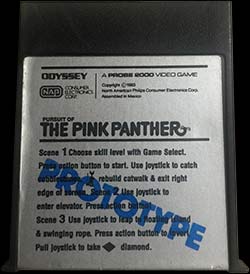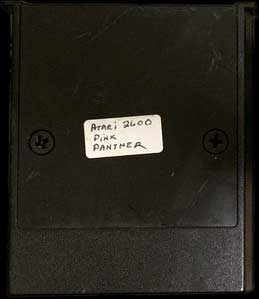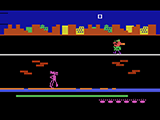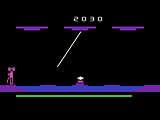MENU
CONTENT
Pursuit of the Pink Panther (Atari 2600)# 3152VC
Game Details
Boxes
No Box data available.
In 1983, Philips licensed the Pink Panther cartoon character with the intention of releasing games for multiple home consoles under its Probe 2000 label. Several prototypes for different platforms were made, but unfortunately, the video game crash intervened and none ever made it to market. An entire novel could be written about the Atari 2600 prototypes' journey out of obscurity, but here is a short history:
The first version of the game was developed by James Wickstead Design Associates for U.S. Games (not Philips). The developers were Roger Booth (Programmer), Todd Marshall (Program/Audio), Robbin Dainels (Graphics), and Jim Wickstead (Game Design). The game was slated to use a new chip called "RAM/ROM" which added 8K of ROM and 2K of RAM. It was slated for release sometime in 1983, but U.S. Games filed for bankruptcy in March of that year.
Philips stepped in, and licensed the game and character as the marketing centerpiece of their upcoming Probe 2000 line. Philips marketing material refers to the game as The Pink Panther, Pink Panther: The Video Game, and Adventures of the Pink Panther, but the final planned title appears to have been Pursuit of the Pink Panther. The game was heavily advertised at the June 1983 Consumer Electronics Show, and was scheduled to be released in September 1983. However, this never happened – Philips blamed problems with the RAM/ROM chip manufacturer – and by January 1984, Probe 2000 was no more.
This is where the saga of the prototypes begins. It all started with a thrift store find in the early 1990s and finally ended(?) with ROM distribution in 2019.
The first version of the game was developed by James Wickstead Design Associates for U.S. Games (not Philips). The developers were Roger Booth (Programmer), Todd Marshall (Program/Audio), Robbin Dainels (Graphics), and Jim Wickstead (Game Design). The game was slated to use a new chip called "RAM/ROM" which added 8K of ROM and 2K of RAM. It was slated for release sometime in 1983, but U.S. Games filed for bankruptcy in March of that year.
Philips stepped in, and licensed the game and character as the marketing centerpiece of their upcoming Probe 2000 line. Philips marketing material refers to the game as The Pink Panther, Pink Panther: The Video Game, and Adventures of the Pink Panther, but the final planned title appears to have been Pursuit of the Pink Panther. The game was heavily advertised at the June 1983 Consumer Electronics Show, and was scheduled to be released in September 1983. However, this never happened – Philips blamed problems with the RAM/ROM chip manufacturer – and by January 1984, Probe 2000 was no more.
This is where the saga of the prototypes begins. It all started with a thrift store find in the early 1990s and finally ended(?) with ROM distribution in 2019.
- 1992: Collector Steve Averitt purchased an unlabeled prototype for $1.50 at a Columbus, OH, thrift store in 1992 (some sources say 1994). He shared screenshots and a discription of the gameplay, but not a ROM image.
- July 2006: The AtariAge webmaster received photos of a labeled prototype cart from an unnamed source. The photos were not shown to anyone else, so this report was considered "unverified" until 2016 (see below).
- Sept. 2006: Magnavox collector Jim "murpho" Murphy of Cumming, GA, who owned two copies of the prototype, sold one on eBay. Once bidding crossed $2K, the auction was cancelled, then relisted with an opening bid of $3,500. The winning bid was $4,750, but reportedly Murphy backed out of the deal.
- 2011: GameGavel auctioned a unlabeled copy for $975.
- 2011: A 5th copy, complete with a label, surfaced on the AtariAge forums.
- Feb. 2016: Murpho listed his other copy on eBay. It sold for an offer below $2,500.
- 2016: "Lockepsb", owner of the unverified proto from 2006, shared photos with the rest of the community. The cart has a Probe 2000 silver label (with the word "Prototype" on it) and is in a ColecoVision-style shell, but the PCB is for the Atari 2600.
- July 2019: two more copies surfaced and were eventually acquired by Ken Van Mersbergen. He distributed the ROM image on AtariAge. This was the first time the ROM had been made generally available. It is playable with the latest Stella emulator.
- At least 50 boxed and numbered copies were made and sold to a select few, for $85 each. One of these was auctioned off at the 2012 Classic Gaming Expo.
- In Oct. 2017, an AtariAge user named "Atari4you" announced that he would produce 20 copies and sold them for $75 each. They didn't materialize until 2019, but sold out at that time.






 SENDING...
SENDING...